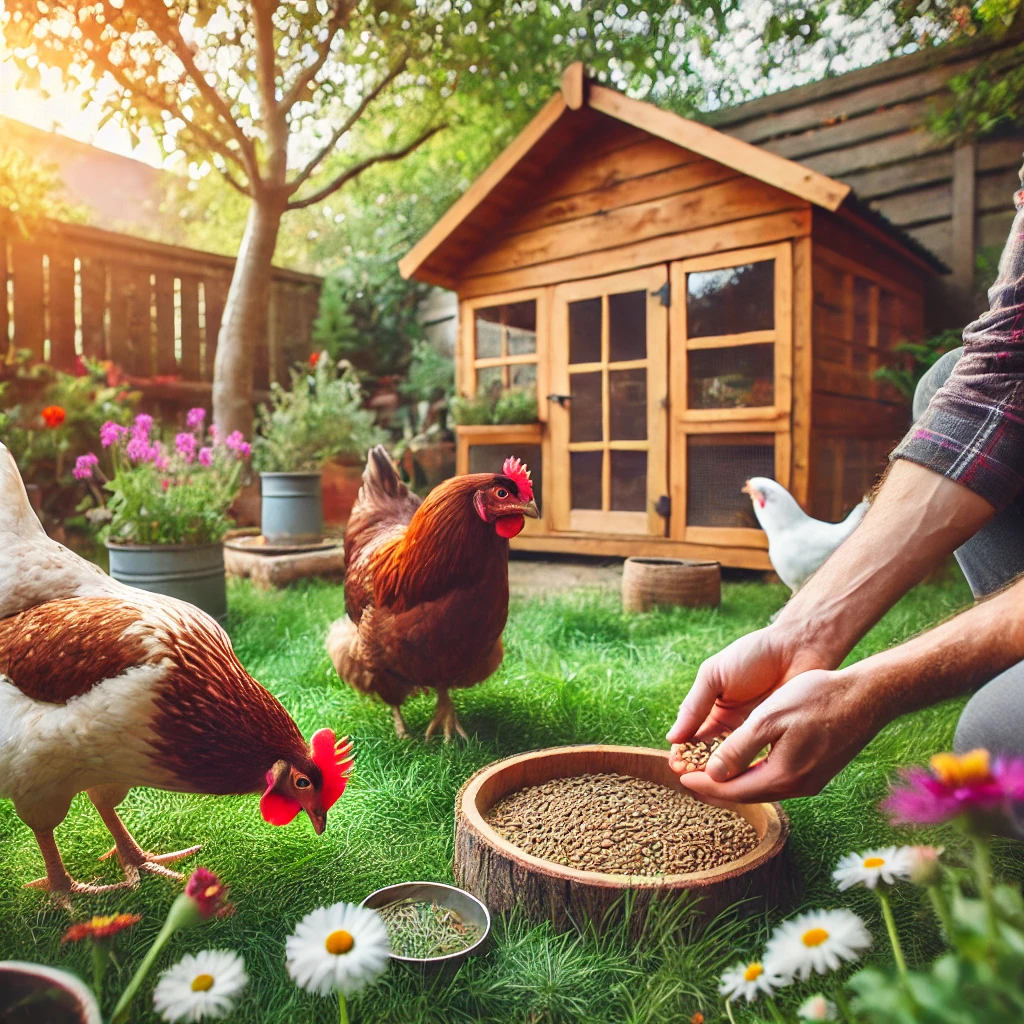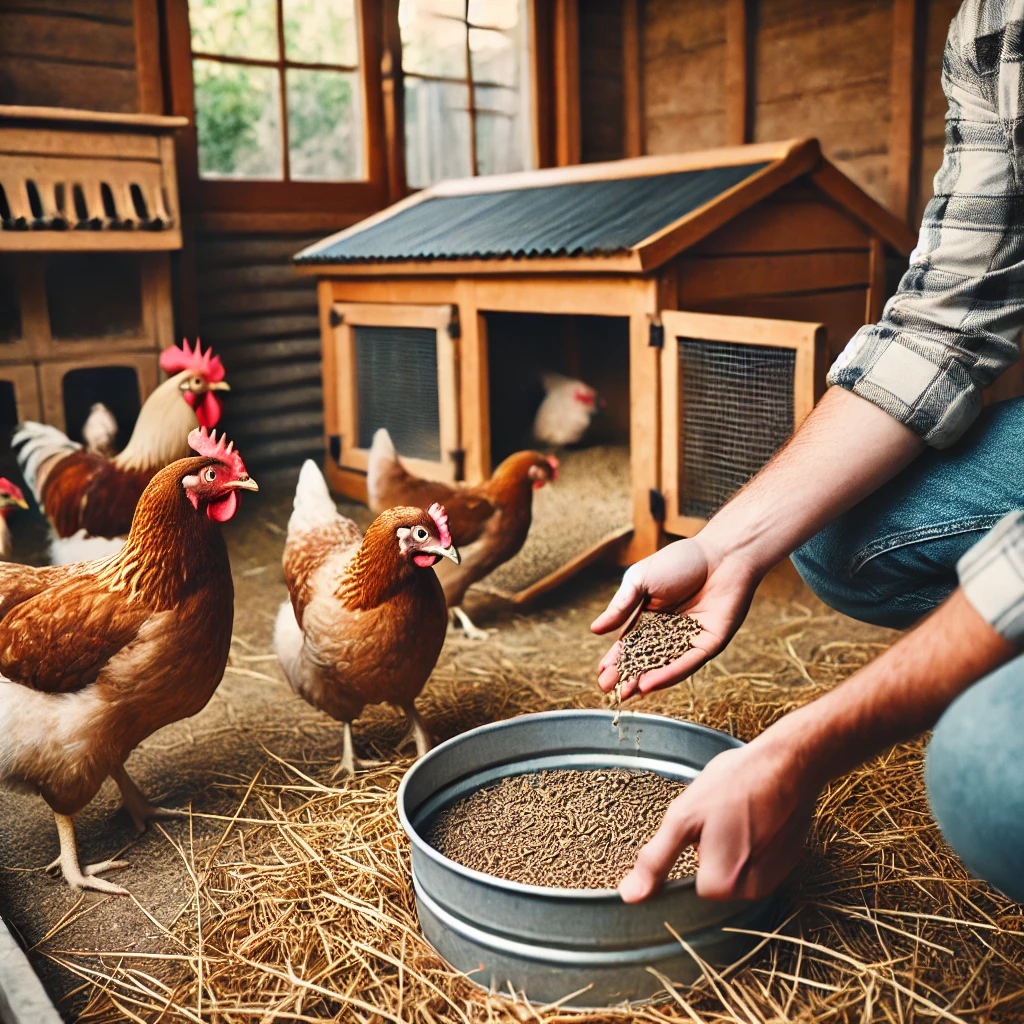
"A beginner-friendly backyard chicken setup featuring a small wooden coop, green grass, and a flock of three chickens foraging peacefully."
Embarking on the journey of backyard chicken keeping is an exciting and rewarding endeavor. However, one of the first questions you’ll face is critical: How many chickens should you start with? Choosing the right number of hens ensures your new hobby remains manageable, cost-effective, and enjoyable. From egg production to space requirements, your flock size depends on several key factors. This guide will help you determine the ideal number of chickens to start with and set you up for success.
1. Family Needs and Egg Production: How Many Chickens Do You Need?
A healthy hen lays around 5 eggs per week or approximately 250 eggs annually. To determine your starting flock size, assess your family’s weekly egg consumption:
- 3 Hens: About 15 eggs per week (suitable for a small family).
- 4 Hens: Around 20 eggs per week (perfect for a family of four).
- 5–6 Hens: Great for larger families or those who enjoy sharing eggs with friends and neighbors.
Pro Tip: If you bake frequently or plan to preserve eggs for the winter, starting with 5–6 hens ensures a surplus for all your needs.
Starting with too many hens can lead to unused eggs, while too few may not meet your household’s needs. Striking the right balance is key.

2. Available Space for Your Chicken Coop: Room for Your Flock
Providing adequate space is essential for healthy and happy chickens. Overcrowding can lead to stress, aggression, and health issues.
Space Requirements Per Chicken:
- Inside the Coop: 2–3 square feet per chicken.
- Outdoor Run: 8–10 square feet per chicken for foraging and exercise.
Example Setup Based on Flock Size:
- 3–4 Hens: 12 square feet inside the coop and 32–40 square feet in the run.
- 5–6 Hens: 15–18 square feet inside the coop and 40–60 square feet in the run.
Pro Tip:
- Small Backyard: Start with 3–4 hens to fit within limited space.
- Larger Yard: If you have more space, consider 6–8 hens for a livelier flock and higher egg production.
Adequate space helps reduce stress and promotes natural behaviors like scratching, dust bathing, and foraging.
3. Time and Effort Commitment: Caring for Your Backyard Chickens
Raising chickens requires daily attention, and the size of your flock will impact your workload.
- Smaller Flock (3–5 Hens): Easier to manage for beginners, requiring less time for feeding, cleaning, and care.
- Larger Flock (6+ Hens): Better for experienced keepers who are comfortable with the routine and increased responsibility.
Daily tasks include:
- Feeding and watering.
- Collecting eggs.
- Cleaning the coop and run.
Pro Tip: Start small to ease into the routine. You can always expand your flock once you feel confident in managing daily care. This gradual approach ensures you avoid feeling overwhelmed.

4. Budget Considerations: How Much Does It Cost to Start With Chickens?
Before starting your flock, it’s essential to account for both initial and ongoing costs.
Initial Costs:
- Coop: $200–$500 or more, depending on size and materials.
- Supplies: $50–$100 for feeders, waterers, and bedding.
Monthly Costs:
- Feed: $10–$15 per chicken.
- 3–4 Hens: $30–$60 per month.
- 5–6 Hens: $50–$90 per month.
Pro Tip: Begin with a flock size that aligns with your budget. Starting small keeps costs manageable and allows you to expand later without financial strain.
5. Local Regulations: How Many Chickens Can You Legally Keep?
Local laws and ordinances often dictate how many chickens you can keep. Common restrictions include:
- Flock Size Limits: Many towns allow 3–6 hens but prohibit roosters due to noise concerns.
- Permits: Some areas require permits for backyard poultry.
- Distance Requirements: Coops may need to be set a specific distance from property lines or neighbors.
Action Step: Research your city or town’s backyard poultry regulations. Contact local officials or search online for the most accurate and up-to-date information.
6. Flock Dynamics: Why Starting With 3–5 Chickens Is Best
Chickens are highly social animals and thrive in groups. Keeping at least three hens ensures companionship, reduces stress, and promotes natural behaviors like foraging and dust bathing
- Small Flock (3–4 Hens): Easier to manage and ideal for beginners.
- Fewer Than 3 Chickens: Risk loneliness if one becomes ill or dies, potentially leading to stress or behavioral issues.
Pro Tip: Aim for 3–5 hens to maintain a healthy, harmonious flock while ensuring you have enough eggs for your needs.

7. Suggested Starting Flock Size for Beginners: 3–5 Chickens to Start With
For most beginners, a flock of 3–5 hens strikes the perfect balance between manageability and production.
- 3–4 Hens: Perfect for small families or those new to chicken keeping. This size ensures minimal stress and steady egg supply.
- 5–6 Hens: Great for larger families or those looking for surplus eggs to share or preserve.
Starting small allows you to learn the basics of care and flock management without feeling overwhelmed. Once you gain experience, you can expand your flock as needed.
Conclusion: Start Small and Expand Your Flock
Starting your backyard chicken journey with a small flock of 3–5 hens is the best way to ease into this rewarding hobby. This approach lets you master the basics of care, provides enough eggs for your family, and keeps your workload manageable. As your confidence grows, you can scale up your flock to suit your family’s needs and goals. Raising chickens should be a fun and fulfilling experience—starting small ensures long-term success.
DARWIN’S TAKE: The Chicken Equation
Backyard chickens are more than just clucking companions; they’re a microcosm of resilience, adaptability, and the delicate balance between nature and nurture. The question of how many chickens to start with isn’t just about eggs or space—it’s a reflection of how much control you want over your food, your time, and your connection to the cycles of life.
Start small, not because simplicity is easier, but because mastery begins with the manageable. A modest flock of 3–5 chickens teaches you the rhythm of care and the weight of responsibility, preparing you for growth, not just in numbers, but in wisdom.
Every peck at the earth, every soft cluck in the morning light, is a rebellion against the industrial monotony of food systems. Each egg is a tangible reminder that sustainability starts in your backyard. The chicken isn’t just a bird; it’s a metaphor for the quiet revolutions we build with our hands and our hearts.
Choose your flock size wisely, for these creatures are more than producers—they are partners in a journey toward self-sufficiency and connection. Start small, dream big, and let the clucking revolution begin.
Sources
These resources offer diverse perspectives and detailed information to help you make informed decisions about starting your backyard chicken flock.
- “Raising Chickens 101: How to Get Started”
This comprehensive guide from The Old Farmer’s Almanac covers the basics of raising chickens, including considerations for flock size based on your needs and resources.
Read more here. - “The Essential Beginners Guide to Backyard Chickens”
BackYard Chickens offers an in-depth article that discusses various factors influencing the number of chickens to start with, such as space, time commitment, and local regulations.
Explore the guide. - “A Beginner’s Guide to Raising Backyard Chickens”
MorningChores provides a detailed PDF guide that includes insights into determining the appropriate flock size for beginners, considering aspects like coop space and maintenance.
Access the PDF. - “Backyard Chickens for Beginners: All You Need to Know”
Raising Happy Chickens offers a series of articles tailored for beginners, addressing key questions about starting a backyard flock, including how many chickens to begin with.
Learn more here. - “Raising Backyard Chickens: A Comprehensive Guide for Beginners”
Texas Real Food provides a thorough guide that discusses selecting the right number of chickens based on your goals, space, and resources.
Read the comprehensive guide.
More Reading on Paranoid Prophet
For those eager to delve deeper into backyard chicken keeping, explore these insightful articles on Paranoid Prophet:
- How Much Space Do Chickens Need? Best Guide for Healthy Backyard Flocks
Understand the spatial requirements essential for maintaining a healthy and stress-free flock. - How to Position and Elevate Your Chicken Feeder for Optimal Health and Cleanliness
Learn effective strategies to place and elevate your chicken feeder, promoting hygiene and reducing feed waste. - Can Chickens Eat Pumpkins? The Health Benefits and Risks Explained
Discover the nutritional advantages and potential hazards of feeding pumpkins to your chickens. - Benefits of Raising Backyard Chickens
Explore the myriad benefits of keeping chickens, from fresh eggs to natural pest control and beyond.
These articles offer comprehensive insights to enhance your backyard poultry experience.
Backyard Chickens FAQ: How Many to Start With and Why
General Questions
Q: How many chickens should I start with as a beginner?
A: For beginners, starting with 3–5 chickens is ideal. This provides a manageable flock size for learning the basics of chicken care while ensuring enough eggs for a small family.
Q: How many eggs do 4 chickens lay in a week?
A: On average, 4 chickens will lay about 20 eggs per week. Each hen produces around 5 eggs weekly, depending on the breed and environmental factors.
Q: How much space do 6 chickens need in a coop?
A: For 6 chickens, you’ll need at least 12–18 square feet inside the coop (2–3 square feet per chicken) and 48–60 square feet in the outdoor run (8–10 square feet per chicken).
Q: Can I start with just 2 chickens?
A: While you can start with 2 chickens, it’s not recommended. Chickens are social animals and thrive in flocks of 3 or more to prevent loneliness and stress.
Care and Maintenance
Q: How much time does it take to care for a flock of 5 chickens?
A: Caring for 5 chickens requires about 10–15 minutes daily for feeding, watering, and egg collection. Weekly coop cleaning may take an additional 30–60 minutes.
Q: What’s the monthly cost of keeping backyard chickens?
A: The monthly cost for 3–5 chickens ranges from $30–$60, covering feed, bedding, and minor maintenance. Initial setup costs, like a coop, are additional.
Q: What do I do if my chickens stop laying eggs?
A: Chickens may stop laying due to stress, reduced daylight in winter, molting, or age. Ensure they have a balanced diet, proper lighting, and a stress-free environment to encourage egg production.
Regulations and Flock Size
Q: Are there laws about how many chickens I can have?
A: Local regulations vary. Many cities allow 3–6 hens but often restrict roosters due to noise concerns. Check your city’s ordinances before starting a flock.
Q: Can I keep chickens in a small backyard?
A: Yes, you can keep chickens in a small backyard if you have enough space for their coop and run. For a small backyard, starting with 3–4 chickens is a good idea.
Expanding Your Flock
Q: When should I expand my flock size?
A: Expand your flock once you’re comfortable with chicken care and have enough space and resources. Adding 2–3 hens at a time is a manageable way to grow your flock.
Q: How do I introduce new chickens to an existing flock?
A: Introduce new chickens gradually by keeping them in a separate but visible area for a week or two. This reduces aggression and helps the birds acclimate to each other.
Health and Well-Being
Q: How can I keep my chickens healthy?
A: Provide a balanced diet, clean water, a secure and spacious coop, and regular health checks. Protect them from predators and extreme weather.
Q: What should I do if one of my chickens gets sick?
A: Isolate the sick chicken immediately and consult a veterinarian experienced with poultry. Keep the rest of the flock in a clean, stress-free environment.


